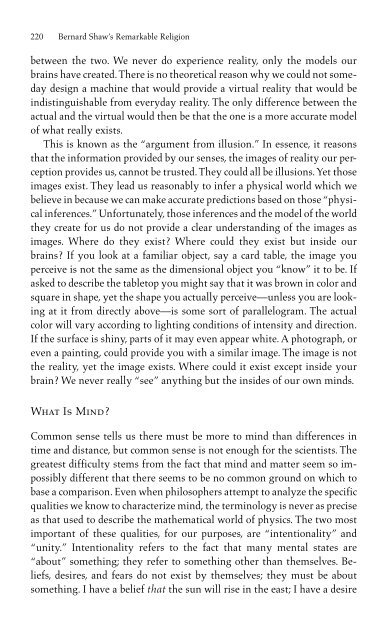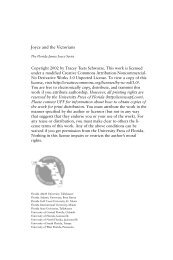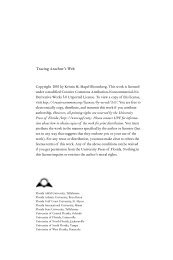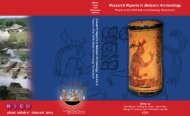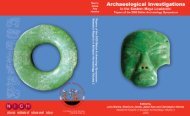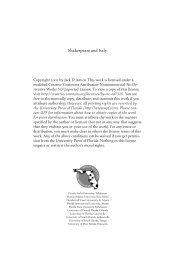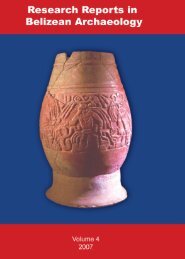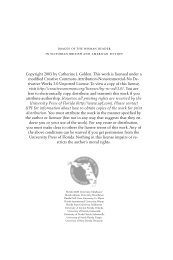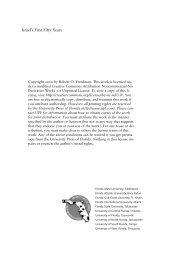Bernard Shaw's Remarkable Religion: A Faith That Fits the Facts
Bernard Shaw's Remarkable Religion: A Faith That Fits the Facts
Bernard Shaw's Remarkable Religion: A Faith That Fits the Facts
Create successful ePaper yourself
Turn your PDF publications into a flip-book with our unique Google optimized e-Paper software.
220 <strong>Bernard</strong> Shaw’s <strong>Remarkable</strong> <strong>Religion</strong><br />
between <strong>the</strong> two. We never do experience reality, only <strong>the</strong> models our<br />
brains have created. There is no <strong>the</strong>oretical reason why we could not someday<br />
design a machine that would provide a virtual reality that would be<br />
indistinguishable from everyday reality. The only difference between <strong>the</strong><br />
actual and <strong>the</strong> virtual would <strong>the</strong>n be that <strong>the</strong> one is a more accurate model<br />
of what really exists.<br />
This is known as <strong>the</strong> “argument from illusion.” In essence, it reasons<br />
that <strong>the</strong> information provided by our senses, <strong>the</strong> images of reality our perception<br />
provides us, cannot be trusted. They could all be illusions. Yet those<br />
images exist. They lead us reasonably to infer a physical world which we<br />
believe in because we can make accurate predictions based on those “physical<br />
inferences.” Unfortunately, those inferences and <strong>the</strong> model of <strong>the</strong> world<br />
<strong>the</strong>y create for us do not provide a clear understanding of <strong>the</strong> images as<br />
images. Where do <strong>the</strong>y exist? Where could <strong>the</strong>y exist but inside our<br />
brains? If you look at a familiar object, say a card table, <strong>the</strong> image you<br />
perceive is not <strong>the</strong> same as <strong>the</strong> dimensional object you “know” it to be. If<br />
asked to describe <strong>the</strong> tabletop you might say that it was brown in color and<br />
square in shape, yet <strong>the</strong> shape you actually perceive—unless you are looking<br />
at it from directly above—is some sort of parallelogram. The actual<br />
color will vary according to lighting conditions of intensity and direction.<br />
If <strong>the</strong> surface is shiny, parts of it may even appear white. A photograph, or<br />
even a painting, could provide you with a similar image. The image is not<br />
<strong>the</strong> reality, yet <strong>the</strong> image exists. Where could it exist except inside your<br />
brain? We never really “see” anything but <strong>the</strong> insides of our own minds.<br />
What Is Mind?<br />
Common sense tells us <strong>the</strong>re must be more to mind than differences in<br />
time and distance, but common sense is not enough for <strong>the</strong> scientists. The<br />
greatest difficulty stems from <strong>the</strong> fact that mind and matter seem so impossibly<br />
different that <strong>the</strong>re seems to be no common ground on which to<br />
base a comparison. Even when philosophers attempt to analyze <strong>the</strong> specific<br />
qualities we know to characterize mind, <strong>the</strong> terminology is never as precise<br />
as that used to describe <strong>the</strong> ma<strong>the</strong>matical world of physics. The two most<br />
important of <strong>the</strong>se qualities, for our purposes, are “intentionality” and<br />
“unity.” Intentionality refers to <strong>the</strong> fact that many mental states are<br />
“about” something; <strong>the</strong>y refer to something o<strong>the</strong>r than <strong>the</strong>mselves. Beliefs,<br />
desires, and fears do not exist by <strong>the</strong>mselves; <strong>the</strong>y must be about<br />
something. I have a belief that <strong>the</strong> sun will rise in <strong>the</strong> east; I have a desire


